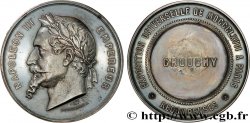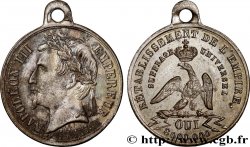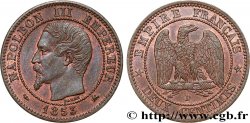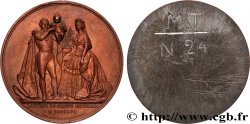fme_498130 - SEGUNDO IMPERIO FRANCES Bataille d’Inkermann
No disponible.
Artículo vendido en nuestra tienda (2018)
Precio : 180.00 €
Artículo vendido en nuestra tienda (2018)
Precio : 180.00 €
Tipo : Bataille d’Inkermann
Fecha: 1854
Metal: cobre
Diámetro: 72 mm
Eje de acuñación: 12 h.
Acuñador OUDINÉ Eugène-André (1810-1887)
Peso: 178,2 g.
Canto: lisse + abeille CUIVRE
Cuño: Abeille CUIVRE
Comentarios sobre el estado de conservación:
Aspect nettoyé au revers. Traces de manipulation. Présence de coups et petites rayures
Anverso
Titulatura del anverso: NAPOLEON III - EMPEREUR.
Descripción del anverso: Tête nue à gauche, signé : E. A. OUDINE. F..
Reverso
Titulatura del reverso: BATAILLE D’INKERMANN // 5. NOVEMBRE 1854..
Descripción del reverso: Femmes ailées aux bustes dénudés personnifiants l’Angleterre et la France, brandissant les drapeaux et tenant entre elles un jeune arbre se terminant en hampe sommée du croissant turc. A l’arrière plan, guerriers russes antiques s’enfuyant sous les foudres. Signé : E. A. OUDINE. F..
Comentario
Faisons remarquer que le poinçon abeille fut utilisé après 1860, jusqu’en 1879. Nous pourrions donc supposer que cet exemplaire fut refrappé. L’exemplaire original devrait être frappé d’une main indicatrice.
La bataille d’Inkermann eu lieu le 5 novembre 1854.
Le plateau d’Inkermann, situé entre Karabelnaia et la vallée de la Tchernaia, en Crimée, était tenu par les anglais. Il fut attaqué par 36 000 russes appuyés par une forte artillerie. Lord Raglan appela les Français. Le général Bosquet lança les deux premiers bataillons qu’il avait sous la main et les fantassins arrêtèrent le mouvement ennemi.
Cette journée coûta 12 000 hommes russes, 2 600 hommes anglais et 1 700 hommes français.
Note that the bee punch was used after 1860, until 1879. We could therefore assume that this example was re-struck. The original example should have been struck with an indicator hand. The Battle of Inkermann took place on November 5, 1854. The Inkermann plateau, located between Karabelnaia and the Tchernaia Valley, in Crimea, was held by the English. It was attacked by 36,000 Russians supported by strong artillery. Lord Raglan called in the French. General Bosquet launched the first two battalions he had at hand and the infantry stopped the enemy movement. This day cost 12,000 Russian men, 2,600 English men and 1,700 French men
La bataille d’Inkermann eu lieu le 5 novembre 1854.
Le plateau d’Inkermann, situé entre Karabelnaia et la vallée de la Tchernaia, en Crimée, était tenu par les anglais. Il fut attaqué par 36 000 russes appuyés par une forte artillerie. Lord Raglan appela les Français. Le général Bosquet lança les deux premiers bataillons qu’il avait sous la main et les fantassins arrêtèrent le mouvement ennemi.
Cette journée coûta 12 000 hommes russes, 2 600 hommes anglais et 1 700 hommes français.
Note that the bee punch was used after 1860, until 1879. We could therefore assume that this example was re-struck. The original example should have been struck with an indicator hand. The Battle of Inkermann took place on November 5, 1854. The Inkermann plateau, located between Karabelnaia and the Tchernaia Valley, in Crimea, was held by the English. It was attacked by 36,000 Russians supported by strong artillery. Lord Raglan called in the French. General Bosquet launched the first two battalions he had at hand and the infantry stopped the enemy movement. This day cost 12,000 Russian men, 2,600 English men and 1,700 French men








 Informar de un error
Informar de un error Imprimir la página
Imprimir la página Comparte mi selección
Comparte mi selección Haz una pregunta
Haz una pregunta Consignar / vender
Consignar / vender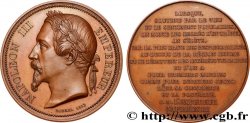
 Descriptivo
Descriptivo